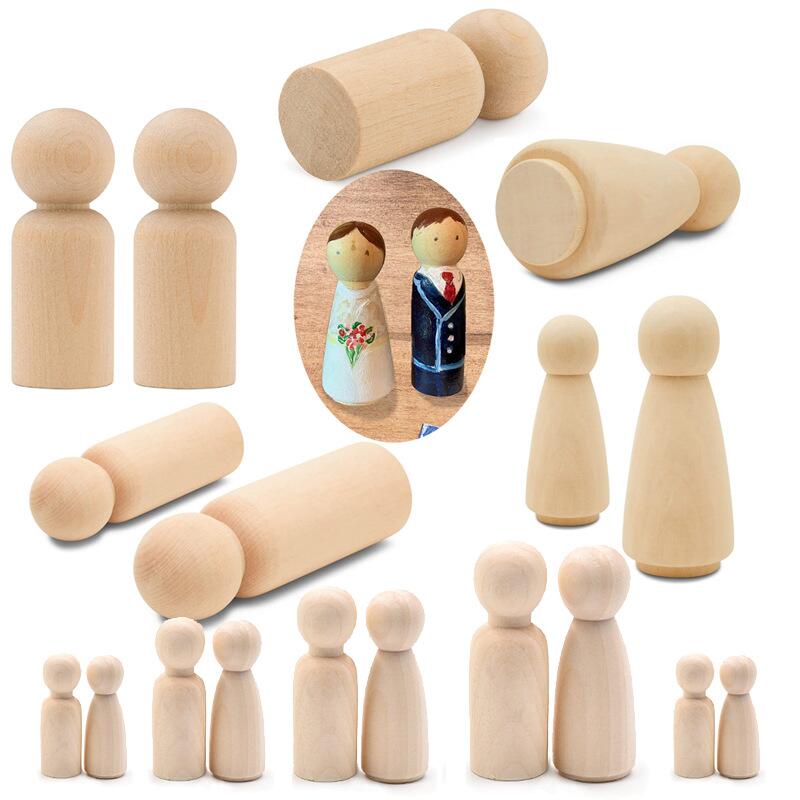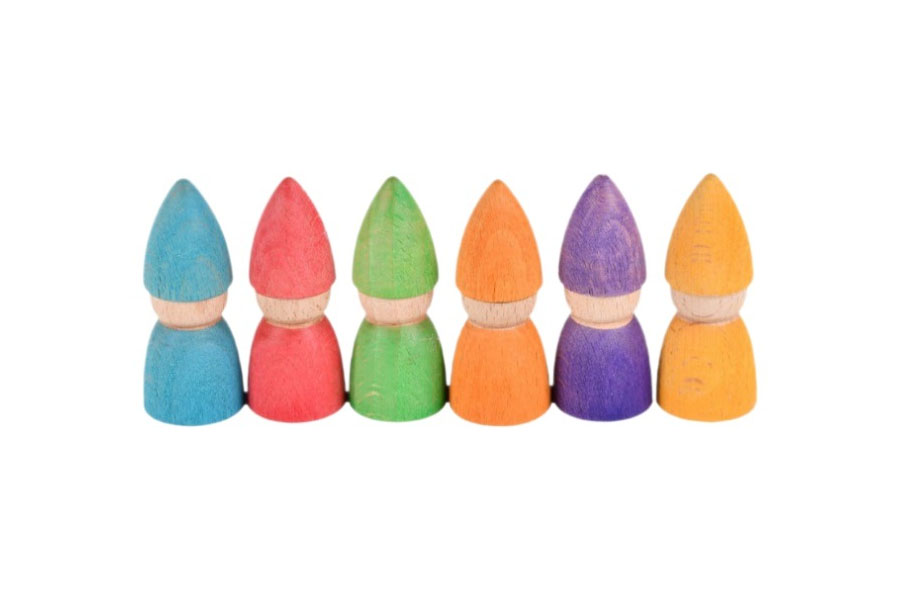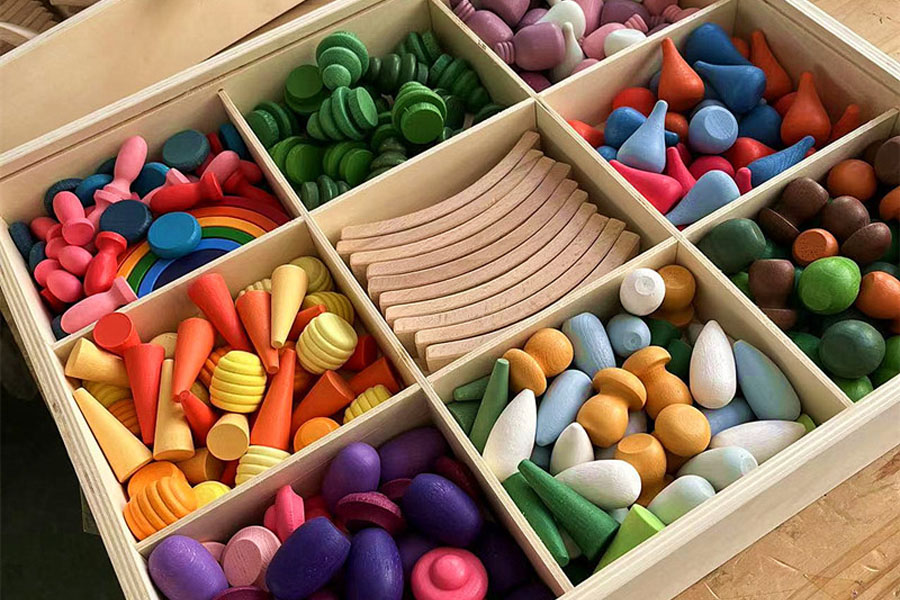When Is the Best Time to Introduce Peg Dolls to Children?
You want to choose toys that perfectly match your child’s age and stage. You worry about introducing something too early, causing frustration or safety issues, or too late, missing a key developmental window.
The best time to introduce peg dolls is from toddlerhood (around 18 months) onward. Start with large, simple dolls for safe grasping, and watch as the toy evolves with your child, supporting new skills at every stage.

As someone who oversees the production of wooden toys, I’ve had the unique opportunity to watch how children interact with our products. It’s fascinating. I’ve seen a 2-year-old simply hold a peg doll, feeling its smooth texture. A year later, that same child uses the doll to create elaborate stories. The toy hasn’t changed, but the child has. This is the magic of a truly great, open-ended toy. It doesn’t dictate the play; it grows with your child’s imagination. Peg dolls aren’t about a single "best age"; they are about a journey that starts in toddlerhood and continues for years.
At what age can toddlers safely play with peg dolls?
You see cute peg dolls but worry about your toddler who still explores the world with their mouth. Choking hazards are a real concern, making you hesitant to buy any small toys.
For toddlers 18 months and older, safety is your first priority. Choose large peg dolls that are specifically designed to be non-choking hazards and are made from solid wood with non-toxic paint.

This question is the most important one for an early introduction, and it’s something we focus on intensely at my factory. The "right age" is less about a number and more about the "right size" of the toy. For any child under three, toys must pass a standard safety test, often represented by a "choke tube." If a toy or any part of it can fit inside this small cylinder, it is not safe for a toddler. When we produce peg dolls for this age group, we use a larger base and a wider form factor. We also ensure they are crafted from a single piece of solid hardwood, like beech or maple, to prevent any small parts from breaking off. The paint must be certified non-toxic (meeting EN71 standards in Europe or ASTM standards in the USA). So, when you choose that first peg doll, look for "toddler-safe" sizing and quality materials.
How do peg dolls support developmental milestones?
You want to invest in toys that are not just fun, but truly educational. You see a simple wooden peg doll and wonder if it can really compete with high-tech "learning" toys.
Peg dolls are developmental powerhouses in disguise. They boost fine motor skills through grasping, advance language with storytelling, and nurture emotional intelligence as children role-play their experiences.

The beauty of a peg doll lies in its simplicity. Because the toy does so little, the child has to do so much, which is where the real learning happens. The developmental support changes as your child grows. A toddler (18 months-3 years) is focused on physical mastery. Just picking up, holding, and placing a peg doll into a toy car builds their pincer grasp and hand-eye coordination. For a preschooler (3-5 years), the play becomes more complex. They begin to give the dolls voices and personalities, which is a massive leap in language development and narrative skills. They use the dolls to act out social situations, like sharing or making friends, which is a safe way to practice empathy and problem-solving. It’s a single toy that meets the needs of multiple developmental stages.
Peg Doll Play Across Ages
| Age Group | Key Development Area | How Peg Dolls Help |
|---|---|---|
| Toddlers (18m – 3 yrs) | Fine Motor Skills | Grasping, placing, early sorting. |
| Preschoolers (3 – 5 yrs) | Language & Social Skills | Storytelling, role-playing emotions, dialogue. |
| Early School Years (5+) | Complex Cognitive Skills | Creating rules for games, simple math, advanced plots. |
When should parents upgrade to themed or detailed peg doll sets?
Your child adores their simple, plain peg dolls. Now you see beautiful, detailed sets of community helpers or knights and wonder if it’s time to "level up" their play.
Introduce themed sets around age 3 or 4, once your child develops specific interests. Think of them as additions to their collection, not replacements for the simple, open-ended dolls that are essential for pure imagination.

This is a great question that gets to the heart of how play evolves. The simple, unpainted, or single-color peg dolls are the foundation. They are the blank slates that can become anyone or anything. Themed sets, like families, community workers, or fantasy characters, serve a different purpose. They help a child dive deeper into a world they are already curious about. If your child is fascinated by doctors after a check-up, a doctor-and-nurse set can help them process that experience. The key is to follow their lead. Introduce these sets to enrich their play, not to direct it. Remember, a firefighter peg doll can always be a firefighter, but a plain blue peg doll can be a firefighter today, a deep-sea diver tomorrow, and a sad rain cloud the next day. You need both types for a rich play environment.
Are peg dolls suitable for seasonal or holiday-themed play?
You are looking for meaningful, hands-on ways to celebrate holidays with your child, moving beyond disposable decorations and endless candy. You want to build lasting family traditions.
Absolutely. Peg dolls are perfect for seasonal play. They can become nativity figures, Halloween monsters, or spring gnomes, making them a tangible and reusable part of your family’s holiday traditions.
![]()
This is one of my favorite uses for peg dolls, and something we see many creative families do. Buying a set of plain, unpainted peg dolls opens up a world of seasonal crafting. They become a beautiful, hands-on way to mark the passing of the seasons and celebrate holidays. Imagine creating a simple nativity scene for Christmas, a spooky family of ghosts for Halloween, or a group of bunnies and chicks for an Easter basket. These aren’t just decorations; they are toys that are created with memory and meaning. This activity builds anticipation for the holiday and gives children a real, physical connection to the celebration. Year after year, bringing out the special box of "holiday peg people" becomes a cherished tradition in itself, far more valuable than any store-bought decoration.
How do peg dolls inspire creativity and storytelling?
Your child’s room is full of toys that make noise and light up. But you notice the play is repetitive, and you crave a toy that will encourage your child to think for themselves.
Peg dolls are a blank canvas. Their simple, featureless form requires a child to become the storyteller. They must invent the characters, create the dialogue, and direct the plot, which is the very essence of creative play.

The magic of a peg doll is in what it lacks. There is no smile or frown telling the child how the doll should feel. There is no uniform telling the child what its job is. This lack of detail is an invitation for the child’s brain to get to work. They look at the doll and have to decide: Who is this? Where are they going? What are they saying? This mental exercise is creativity in its purest form. They are not just re-enacting a story they saw on TV; they are building a world from the ground up. This process builds critical thinking, vocabulary, and narrative skills. Using the dolls to role-play also provides a safe space for them to explore emotions and social situations, like how to be a kind friend or how to be brave.
Can peg dolls be used for math and counting games?
You want to introduce early math concepts without resorting to boring flashcards. You’re looking for a playful, hands-on tool that you might already have in your toy box.
Yes, peg dolls are a fantastic manipulative for early math. They make abstract concepts like counting, sorting, and simple addition tangible and fun for young learners.

Before children can understand numbers on a page, they need to understand quantity in the real world. Peg dolls are perfect for this. Their discreet, uniform shape makes them ideal counters. You can move beyond simple counting to more complex ideas in a very intuitive way. This hands-on approach builds a deep, foundational understanding of math that can’t be achieved with a worksheet. It transforms math from a chore into a game.
Simple Math Games with Peg Dolls
| Math Concept | Game Idea |
|---|---|
| Counting & Cardinality | Line up the dolls and count them. Ask "How many are there?" |
| Sorting & Classifying | "Let’s put all the red dolls in the house and all the blue dolls in the garden." |
| Simple Operations | "If 3 people are at the party and 2 more arrive, how many are there now?" |
| One-to-One Correspondence | "Let’s give every person one block to sit on." |
Conclusion
The best time to introduce peg dolls is now. They are a uniquely versatile toy that safely meets a toddler’s grasp and grows to match a child’s expanding mind, fostering creativity at every stage.












